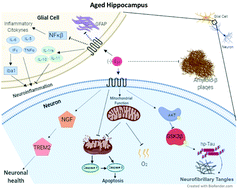Effects of (−)-epicatechin on neuroinflammation and hyperphosphorylation of tau in the hippocampus of aged mice
Abstract
Evidence has implicated oxidative stress (OS) and inflammation as drivers of neurodegenerative pathologies. We previously reported on the beneficial effects of (−)-epicatechin (Epi) treatment on aging-induced OS and its capacity to restore modulators of mitochondrial biogenesis in the prefrontal cortex of 26-month-old male mice. In the present study using the same mouse model of aging, we examined the capacity of Epi to mitigate hippocampus OS, inflammation, hyperphosphorylation of tau protein, soluble β-amyloid protein levels, cell survival, memory, anxiety-like behavior levels and systemic inflammation. Mice were subjected to 4 weeks of Epi treatment (1 mg kg−1 day−1) and samples of the hippocampus were obtained. Assessments of the OS markers, protein carbonyls, and malondialdehyde levels demonstrated their significant increase (∼3 fold) with aging that were partially suppressed by Epi. The protein levels of the glial fibrillary acidic protein, inflammatory factor 1 (Iba1), pro-inflammatory cytokines, interleukins (IL-1β, IL-3, 5, 6 and 15), cyclooxygenase 2, tumor necrosis factor α, nuclear factor-activated B cells and interferon γ increase with aging and were also significantly decreased with Epi treatment. However, anti-inflammatory cytokines, IL-1ra, IL-10 and 11 decrease with aging and were restored with Epi. Epi also reversed the aging effects on the hyperphosphorylation of tau, increased soluble β-amyloid levels (∼2 fold), cellular death (as per caspase 3 and 9 activity), and reduced nerve growth factor and triggering receptor expressed on myeloid cells 2 levels. Measures of anxiety like-behavior and memory demonstrated improvements with Epi treatment. Indicators of systemic inflammation increase with aging and Epi was capable of decreasing blood inflammatory markers. Altogether, the results show a significant capacity of Epi to mitigate hippocampus OS and inflammation leading to improved brain function.

- This article is part of the themed collection: Food & Function Recent HOT articles


 Please wait while we load your content...
Please wait while we load your content...
